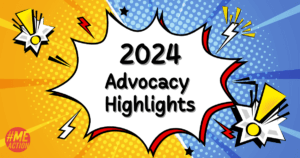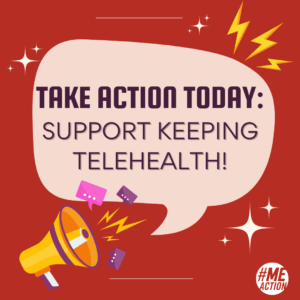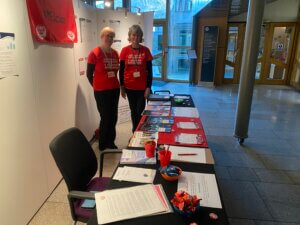We are thrilled to honor Terri Wilder as our fall Volunteer of the Month. Terri spearheaded the protest and petition against Per Fink last month where the community took a stand against the harmful treatments that Per Fink has forced upon people with ME.
Terri Wilder has been a monumental activist with #MEAction since getting diagnosed with ME in 2016. We are in awe of her commitment to fight for real solutions for our community.
Terri was part of the voluntary steering committee that shaped the direction of the first #MillionsMissing global protest in 2016. Her involvement with #MEAction New York has led to important achievements in the past few years, including the New York State Department of Health launching a website about myalgic encephalomyelitis (ME), and the New York State health commissioner, Dr. Howard Zucker, sending out a letter to over 85,000 physicians to educate them about ME. Just last week – after working for a year to make it a reality – Terri was able to secure a one-hour listening session between the New York City Council Health Chair and people with ME.
Born and raised in Georgia, Terri has fought for the rights of people living with HIV since 1989. Inspired by her advocacy work with ACT UP, she applies lessons learned from the AIDS movement to her ME activism. Having seen the incredible progress that the AIDS community made through grassroots organizing, Terri is committed to both “indoor” and “outdoor” activism, meaning she’s not afraid to protest when the government fails a community.
What made you want to get involved with #MEAction activism?
The reason I got involved was because I was diagnosed with ME in March of 2016. I have an activist background dating back to 1989 in HIV and LGBTQ rights. I had spent all this time as an activist, and now I needed to engage in activism for myself. I was shocked by what I had stumbled into – the lack of medical care and research, and the lack of the government’s response to the disease. It seemed as if nobody cared if we live or die. It was a no-brainer that I had to engage in activism.
I heard about #MEAction through a friend, Peter Staley, who is a famous AIDS and LGBT activist. He was speaking on a panel with Jennifer Brea. Peter told me that Jen was making a film, and I landed on #MEAction’s website where I started reading about ME. I called Peter and said, “Holy shit. I think i have what she has. I need to get in touch with her.” This is how I figured out that I might have this disease, and got connected to a medical provider. If I hadn’t been friends with Peter Staley, I might not have gotten diagnosed. I might be dead.
Jen and I ended up having a 3-hour lunch. My brain fog was so bad that I wasn’t even sure if I was making sense. She gave me the name of three medical providers in the area, and one of them, Dr. Susan Levine, took health insurance.
Tell us a little about your experience with ME activism. What has been the highs and lows?

Photo by Michelle Wild.
I’m often challenged by people who aren’t comfortable by that form of activism and express disappointment about me doing this. I don’t think that anything is going to change if we don’t engage in nonviolent civil disobedience. It doesn’t seem like other tactics are working. I’m a proponent of the inside-outside strategy. It’s so much easier to sit down with people and have an adult conversation but if we’re not moving the needle, they leave us no other choice but to get in their face.
All of my friends with HIV are alive because of the people in ACT UP and other HIV activists around the globe who engaged in nonviolent civil disobedience. HIV activists had to get in the face of the government. The ME community needs to get in the faces of those who are discriminating against us to show that we are powerful and that, together, we demand our human rights – that ultimately, we have a right to live, a right to healthcare, a right to live our lives with dignity.
I meet people who’ve lived with this disease for 30 to 40 years and have had their lives destroyed. It’s criminal that there are medical providers who tell us this is all in our heads. They’re engaging in malpractice, and someone needs to file a lawsuit against them.
What is your story with ME?
I was diagnosed less than three years ago in March of 2016. At the time, I felt like I was dying. I was so severely ill, I could barely get to Dr. Levine’s office. She was shocked that I was still working. I was barely making it. It was a struggle to get to work and back. I’d collapse as soon as I got home, and would spend the whole weekend in bed. She immediately started me on valtrex. I also moved out of an apartment that had mold in it. I started IVIG and IVs with vitamins. I removed gluten from my diet, and watch my sugar intake. One-and-a-half years ago, I started on low dose Naltrexone. I pace myself, and try not to do too much. Usually, I have to go home and lie down but it’s a lot different than it was in 2014. Now, it’s more of a practice to come home, shut down, get calm, eat some food and lie down with my cat, Leonard.
Even though I was diagnosed three years ago with ME, I’m pretty sure that I’ve had this since the nineties. I had gotten really sick in 1996 and had all this blood work done but all the doctor told me was that I had a yeast infection, and that the rest of my blood work was fine. The practitioner didn’t know to order labs typically ordered for people with ME as I’m sure she didn’t know about ME or think to put it on the differential diagnosis. During that time, I really thought my parents were going to have to order a coffin for me – that’s how sick I felt. I could barely take a shower and was bed bound for a year-and-a-half, and had to move in with my mother.
Interestingly, my grandmother suggested that I see a chiropractor she knew who specializes in eastern medicine. He told me that I was being eaten alive by yeast, that something was really wrong with my immune system and that he thought that I had Fibromyalgia. He started me on a protocol of supplements and a special diet. I don’t think he knew that he was treating ME. I truly believe that he stopped the clock in me getting sicker.
I gradually started getting better where I could volunteer one day a week at my friends AIDS organization and answer the phone for three hours. And then, I would go home and crash. Eventually, it got to the point where I could work two shifts and then three, and then five, and then part-time and then full-time work. I still had to rest a lot, and would still get really wiped out.
Years later, I went through perimenopause and I think it triggered the disease to come back. It flipped the switch.
I still have a lot of information to learn and people to meet, but the stories that I hear are horrifying. In some ways, I think that I’ve been lucky. I had a very supportive family from the beginning. It probably took me one-and-a-half years before I had that dreaded experience with a medical provider who said that ME wasn’t real. I was baptized that day. It was a cardiologist. But, I already had a diagnosis and care, and I knew not to listen to her, so I walked out and called the next day and complained.
I have health insurance, and access to a provider who understands ME. I’ve had the opportunity to get care, which is an experience that lot of people with ME don’t have. It breaks my heart to meet people virtually who are bed bound and so sick that they can’t even travel to see an expert, or they don’t have the money to pay out-of-pocket. In some ways, I’ve been very privileged, which is why I feel so strongly about engaging in activism.
What gives you hope?
 People who showed up to protest Per Fink. The 10,000 people who signed the petition calling out Per Fink on his bullshit. The New York State Department of Health putting up a website about ME. The New York State health commissioner who sent out a government letter to 85,000 physicians saying that our disease is real.
People who showed up to protest Per Fink. The 10,000 people who signed the petition calling out Per Fink on his bullshit. The New York State Department of Health putting up a website about ME. The New York State health commissioner who sent out a government letter to 85,000 physicians saying that our disease is real.
Last week, the New York City Council Health Chair, Mark Levine, held a one-hour listening session by phone with people with ME. People could also email public comment and share their stories of having ME. It took nine months to set this up. What we really need in New York state and city is dedicated budget lines for ME. At the end of day, we know that money makes things happen. #MEAction New York’s goal for next year is to get money and a budget for ME in the state and city budget.
Any advice?
My best advice is to use every relationship you have to get to people in power. Somebody knows somebody who knows somebody. That’s how we got the New York State commissioner to send out a letter to over 85,000 physicians about ME, that’s how we got a listening session with City Council Member Mark Levine.
People don’t give to an organization, they give to other people. People write a check for a person or because they’re personally moved by something. It happens through establishing relationships. The other day, my friend was on CNN so I went to the studio with him. Now, I have a relationship with a producer and, believe me, I’m working on that relationship.
Who did your parents go to school with, who does your uncle know? Really think about your network.
We need to be working together as a community and not fighting each other. We need to be fighting ME and not people with ME. If you have the energy to fight another person with ME, then your target is wrong. Who is trying to destroy our lives, who is not giving us access to healthcare, who is not helping us get back to our lives is who we should be fighting. If you’re fighting against people with ME, you’re not an activist, you’re just a bully.

Why You Should Gift to #MEAction this Season
As #MEAction prepares for the year ahead, I’m thrilled to share with you a few highlights from the incredible advocacy projects our staff has undertaken this past year. As you prepare for the holidays, I humbly ask that you consider making a gift to #MEAction today to keep our work going strong! Donate We Organized





7 thoughts on “Volunteer of the Month – the Woman Behind the Per Fink Protest”
Thank you Terri, so many of us locked in our homes unable to participate in life. Keep fighting for us, we need help so desperately!
Beautifully said. I agree 1000%. Thank you Terri, for all you do!
“All of my friends with HIV are alive because of the people in ACT UP and other HIV activists around the globe who engaged in nonviolent civil disobedience. HIV activists had to get in the face of the government. The ME community needs to get in the faces of those who are discriminating against us to show that we are powerful and that, together, we demand our human rights – that ultimately, we have a right to live, a right to healthcare, a right to live our lives with dignity.”
We need to ACT UP as much like ACT UP as we practicably can. They were a marginalized community ignored and abused and ACT UP activism got massive funding so now HIV is a manageable disease.
Jesse Helms’ speech on the floor of the Senate says it all:
“If they would keep their mouths shut, no one would ever say a word; and we wouldn’t know anything about it. But NO, they march in the streets! they DEFY you!”
https://www.youtube.com/watch?v=Mp-UBv_JsjU&fbclid=IwAR1y4xGjEUaZSIj0P3NCL5MSHN5SgFKCj-zhnr5irK3UQtsW1iz_fcBBWR8
Excellent. Terri is a real roll model.
Thank you for lightening my heart today !! keep at it !! awesome work …and so needed
Leslie
Terrific! I watched the NY protest from far away Germany (having signed the letter as my husband,too). I wished we had so brilliant fighters for our cause in Germany,too!
Thank you, Terri! You fight for pwme in the whole world!
This is great, thanks for sharing!
Comments are closed.